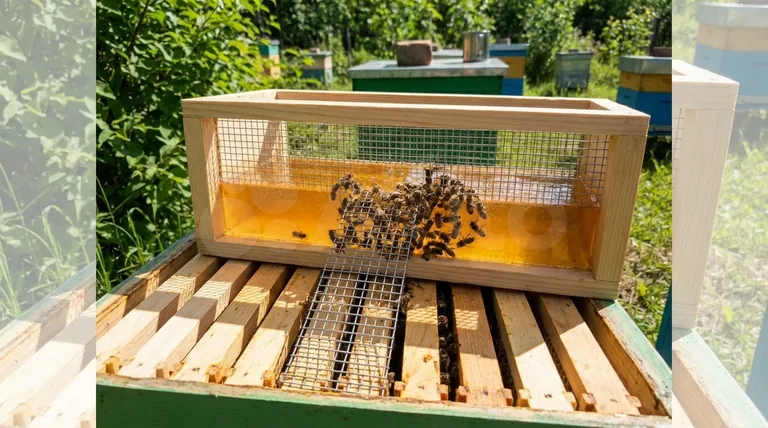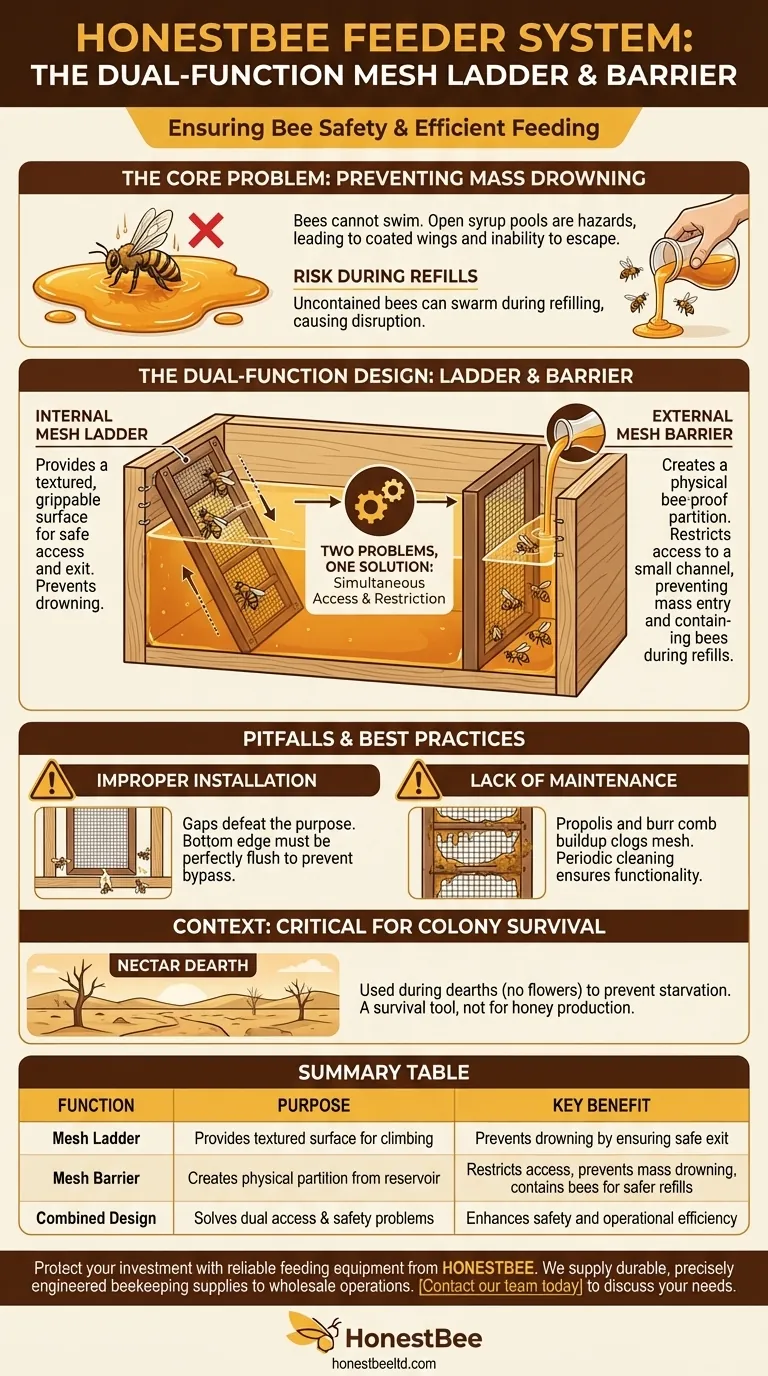At its core, the mesh assembly in a feeder box serves a dual function that is critical for bee safety and efficient feeding. It acts as an internal ladder, allowing bees to safely access the syrup and climb out, while simultaneously creating a physical barrier that prevents them from entering the main reservoir where they could easily drown.
The primary challenge of in-hive feeding is providing access to syrup without endangering the bees. The mesh ladder and barrier design is a simple but effective engineering solution to prevent widespread drowning, a common and avoidable cause of colony loss during feeding.

The Core Problem: Preventing Mass Bee Drowning
Foraging bees are naturally drawn to sugar syrup, but large, open surfaces of liquid are a significant hazard. The design of an in-hive feeder must account for this behavior to prevent unnecessary losses.
Why Bees Drown in Feeders
Bees cannot swim. When they fall into a pool of sticky syrup, their wings become coated, and they are unable to escape. An open-style feeder without a proper access ramp can quickly become a death trap for hundreds or even thousands of bees.
The Risk During Refills
The barrier's second function becomes critical when you open the hive to refill the feeder. It contains the bees within their small access corridor, preventing them from flying out or swarming into the main syrup chamber as you pour. This makes refilling faster, safer, and less disruptive to the colony.
A Closer Look at the Dual-Function Design
The effectiveness of this system lies in how two simple pieces of mesh solve two different problems simultaneously. One part provides access, while the other restricts it.
The Internal Ladder
The mesh component located inside the bees' access area functions as a ladder. It is stapled along the wall, providing a textured, grippable surface that extends down into the syrup. This ensures bees can securely climb down to drink and, more importantly, climb back out without falling in.
The External Barrier
A separate piece of mesh is installed to wall off the main syrup reservoir. It is carefully cut and bent to span the interior of the box, creating a bee-proof partition. This design intentionally limits the bees' access to a small, controlled channel, keeping them safely away from the vast majority of the liquid. A secure seal at the bottom is critical to prevent bees from crawling underneath.
Understanding the Pitfalls and Best Practices
While the design is effective, its success depends entirely on proper installation and maintenance. A poorly executed setup can completely negate the safety features.
Improper Installation
The single most common failure point is a poorly fitted barrier. If there are gaps along the sides or bottom, curious bees will find them. This allows them to access the main reservoir, defeating the entire purpose of the barrier and leading to the very drowning incidents it was designed to prevent. The bottom edge must be perfectly flush.
Lack of Maintenance
Over time, bees will coat surfaces inside the hive with propolis and burr comb. This buildup can clog the mesh ladder, making it less effective as a climbing surface. It's important to periodically inspect and clean the mesh to ensure it remains fully functional.
When and Why Feeders Are Necessary
Understanding the purpose of the feeder itself gives context to why its design is so important. Feeders are not used year-round but are a critical tool for colony survival.
Identifying a Nectar Dearth
Beekeepers use feeders during a nectar dearth—a period when there are few or no nectar-producing flowers in bloom. This can occur in late summer, during a drought, or in early spring before the first flowers appear.
The Goal of Supplemental Feeding
The purpose of feeding is to prevent the colony from starving. A feeder filled with sugar syrup provides the carbohydrates a colony needs to survive until natural forage becomes available again. It is a management tool for survival, not for honey production.
Applying This to Your Hive
When building, buying, or using a feeder, your primary objective should always be bee safety.
- If your primary focus is colony survival: Ensure the mesh barrier is securely installed with absolutely no gaps and that the ladder provides an ample, clean climbing surface.
- If your primary focus is building your own equipment: Pay meticulous attention to cutting the barrier mesh to the exact width and sealing its bottom edge to prevent bees from bypassing the safety mechanism.
- If your primary focus is ease of use: Choose or build feeders that allow easy access for refilling without disturbing the bees contained behind the barrier.
Ultimately, a well-designed feeder protects your most valuable asset: the bees themselves.
Summary Table:
| Function | Purpose | Key Benefit |
|---|---|---|
| Mesh Ladder | Provides a textured surface for bees to climb in and out. | Prevents bees from drowning by ensuring a safe exit from the syrup. |
| Mesh Barrier | Creates a physical partition between bees and the main syrup reservoir. | Restricts bee access to a safe channel, preventing mass drowning incidents. |
| Combined Design | Solves the dual problem of access and safety simultaneously. | Makes refilling faster and less disruptive by containing bees during the process. |
Protect your investment and ensure your colonies thrive with reliable feeding equipment from HONESTBEE.
We supply durable, well-designed beekeeping supplies and equipment to commercial apiaries and distributors through our wholesale-focused operations. Our feeders are built with the precise engineering details—like secure mesh barriers and effective ladders—that are critical for bee safety and operational efficiency.
Let us help you equip your operation with the tools for success. Contact our team today to discuss your wholesale needs and discover the HONESTBEE difference.
Visual Guide

Related Products
- HONESTBEE Advanced Ergonomic Stainless Steel Hive Tool for Beekeeping
- Professional Dual-End Stainless Steel Hive Tool for Beekeeping
- Professional 3-Bar Frame Grip with Integrated Hive Tool
- Multi-Functional Sliding Hive Entrance for Beekeeping
- Plastic Bee Hive Stand for Beekeeping
People Also Ask
- How should beekeepers handle bees when using a hive tool? Master Calm, Deliberate Techniques
- What tools are used for cleaning frames? A Beekeeper's Simple 4-Tool Guide
- What is a hive tool and what are its uses? Master Your Hive Inspections with the Essential Beekeeper's Tool
- What are the features of a regular hive tool? The Essential Multi-Tool for Every Beekeeper
- What is the hole in a hive tool for? A Multi-Tool for Apiary Repairs and Maintenance



















